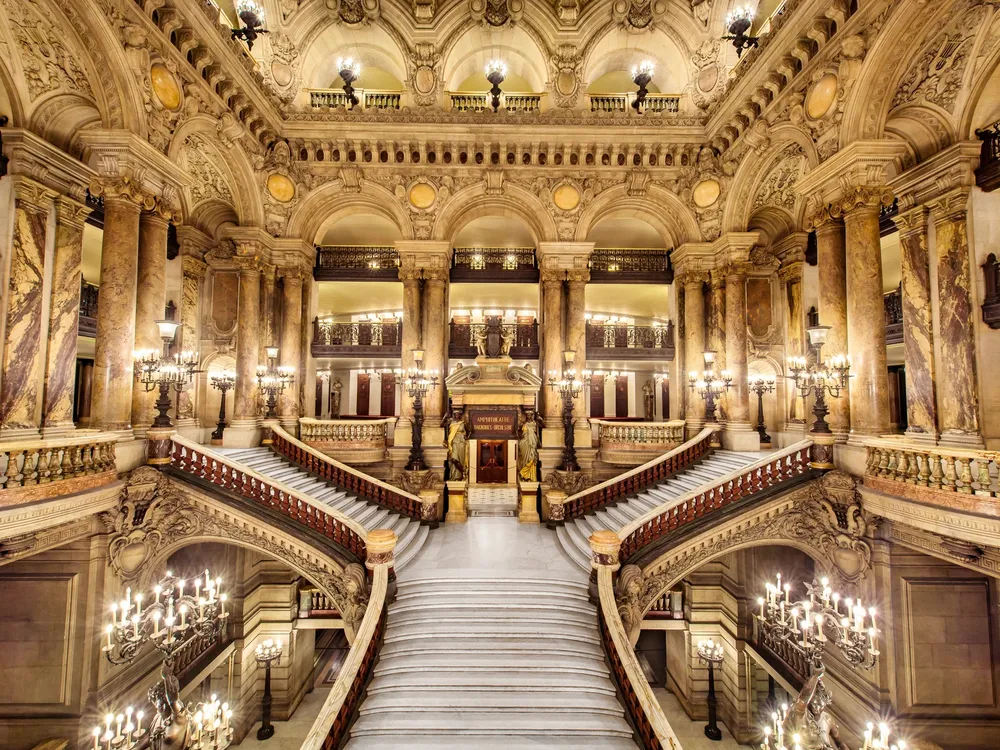Palais Garnier 🎼 Opéra de Paris

A Journey into its Inception and History
In the tradition of Italian theater, the horseshoe-shaped "French" auditorium, so-called for the way the seats are arranged according to their category, was designed for the audience to see and to be seen.
Its metallic structure, hidden by marble, stucco, velvet and gilding, supports the weight of the 8-ton bronze and crystal chandelier with its 340 lights. The ceiling painted by Marc Chagall and commissioned by the Minister of Culture André Malraux was inaugurated on September 23, 1964.
Its metallic structure, hidden by marble, stucco, velvet and gilding, supports the weight of the 8-ton bronze and crystal chandelier with its 340 lights. The ceiling painted by Marc Chagall and commissioned by the Minister of Culture André Malraux was inaugurated on September 23, 1964.
After your visit why not walk a couple of blocks to the rooftop of Le Printemps. A famous chic french department store where a spectacular view of Paris awaits you the perfect finale to a spectacular day.

Opéra Garnier 4K
Inside Paris Opéra
Inside Paris Opéra
The Palais Garnier - also known as Opéra Garnier is a historic 1,979-seat opera house at the Place de l'Opéra in the 9th arrondissement of Paris, France. It was built for the Paris Opera from 1861 to 1875 at the behest of Emperor Napoleon III. Initially referred to as le nouvel Opéra de Paris (the new Paris Opera), it soon became known as the Palais Garnier, "in acknowledgment of its extraordinary opulence" and the architect Charles Garnier's plans and designs, which are representative of the Napoleon III style. It was the primary theatre of the Paris Opera and its associated Paris Opera Ballet until 1989, when a new opera house, the Opéra Bastille, opened at the Place de la Bastille. The company now uses the Palais Garnier mainly for ballet. The theatre has been a monument historique of France since 1923.

Welcome at the Palais Garnier
The Palais Garnier has been called "probably the most famous opera house in the world, a symbol of Paris like Notre Dame Cathedral, the Louvre, or the Sacré Coeur Basilica". This is at least partly due to its use as the setting for Gaston Leroux's 1910 novel The Phantom of the Opera and, especially, the novel's subsequent adaptations in films and the popular 1986 musical. Another contributing factor is that among the buildings constructed in Paris during the Second Empire, besides being the most expensive, it has been described as the only one that is "unquestionably a masterpiece of the first rank".
The Palais Garnier also houses the Bibliothèque-Musée de l'Opéra de Paris (Paris Opera Library-Museum), which is managed by the Bibliothèque Nationale de France and is included in unaccompanied tours of the Palais Garnier.

Architecture and Style
The opera was constructed in what Charles Garnier (1825–1898) is said to have told the Empress Eugenie was "Napoleon III" style The Napoleon III style was highly eclectic, and borrowed from many historical sources; the opera house included elements from the Baroque, the classicism of Palladio, and Renaissance architecture blended together.
These were combined with axial symmetry and modern techniques and
materials, including the use of an iron framework, which had been
pioneered in other Napoleon III buildings, including the Bibliothèque Nationale and the markets of Les Halles.
Paris Opéra Palais Garnier
Immersive 360° Tour 4K 🇫🇷

Celebrating 350 Years of Paris's Iconic Opera
This week, we're taking you on a tour of one of Paris's most iconic sites, as we mark the 350th anniversary of France's Opera. Created by the Sun King Louis XIV in 1669, the world's first permanent dance academy consists today of both the Garnier Palace, inaugurated in 1875, and the 30-year-old Bastille Opera.

L'opéra Garnier, ou palais Garnier, est un théâtre national qui a la vocation d'être une académie de musique, de chorégraphie et de poésie lyrique ; il est un élément majeur du patrimoine du 9e arrondissement de Paris et de la capitale. Il est situé place de l'Opéra, à l'extrémité nord de l'avenue de l'Opéra et au carrefour de nombreuses voies.
L'édifice s'impose comme un monument particulièrement représentatif de l'architecture éclectique et du style historiciste de la seconde moitié du XIXe siècle. Sur une conception de l'architecte Charles Garnier retenue à la suite d’un concours, sa construction, décidée par Napoléon III dans le cadre des transformations de Paris menées par le préfet Haussmann et interrompue par la guerre de 1870, fut reprise au début de la Troisième République, après la destruction par incendie de l'opéra Le Peletier en 1873. Le bâtiment est inauguré le par le président Mac Mahon sous la IIIe République.
Garnier 🎼 Paris Opéra
Cet opéra a été appelé « opéra de Paris » jusqu'en 1989, date à laquelle l'ouverture de l'opéra Bastille,
également opéra de Paris, a influé sur son appellation. On le désigne
désormais par le seul nom de son architecte : « opéra Garnier » ou
« palais Garnier ». Les deux opéras sont aujourd'hui regroupés au sein de l'établissement public à caractère industriel et commercial « Opéra national de Paris », institution publique
française dont la mission est de mettre en œuvre la représentation de
spectacles lyriques ou de ballet, de haute qualité artistique.
L'opéra Garnier est classé monument historique depuis le . Il est accessible par le métro (station Opéra), par le RER (ligne A, gare d'Auber) et par le réseau de bus RATP.



.gif)
No comments:
Post a Comment